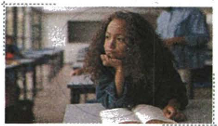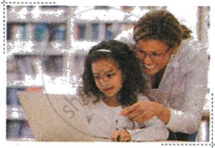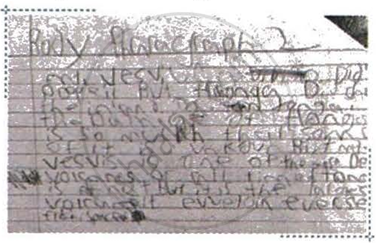Advertisements
Chapters
1: Budgeting and Savings
2: Space Organisation in the Kitchen
3: Home Furnishings
UNIT 2: GROWTH AND DEVELOPMENT DURING MIDDLE CHILDHOOD
4: Milestones of Development
5: Role of Family, Peer Group and School
▶ 6: Learning Disabilities in Children
UNIT 3: MEAL PLANNING
7: Balanced Diet
8: Meal Planning for the Family
9: Storage and Preservation of Food
UNIT 4: SELECTION AND CARE OF TEXTILE AND CLOTHING
10: Selection of Fabrics
11: Selection of Readymade Garments
12: Laundering
13: Laundry Material
UNIT 5: COMMUNICATION AND EXTENSION
14: Social and Economic Issues in India
15: Role of Government Towards A Developed India
16: Communication Aids
![Oswal solutions for Home Science [English] Class 10 ICSE chapter 6 - Learning Disabilities in Children Oswal solutions for Home Science [English] Class 10 ICSE chapter 6 - Learning Disabilities in Children - Shaalaa.com](/images/home-science-english-class-10-icse_6:c4a0817a5384439cbcd4223e2bb15b2b.jpg)
Advertisements
Solutions for Chapter 6: Learning Disabilities in Children
Below listed, you can find solutions for Chapter 6 of CISCE Oswal for Home Science [English] Class 10 ICSE.
Oswal solutions for Home Science [English] Class 10 ICSE 6 Learning Disabilities in Children EXERCISES [Pages 71 - 73]
MULTIPLE CHOICE QUESTIONS Fill in the blanks
Learning disorder is a ______ condition that affects the brain's ability to send, receive, and process information.
Physiological
Physical
Psychological
Neurological
The above-average intelligence is also termed as ______.
Hidden disabilities
Normal intelligence
IQ
Higher skills
One can recognize the signs of learning disability for a Preschool-age child by ______.
Pronunciation problem
Difficulty in rhyming words
Avoids writing assignments
Difficulty in following directions
Choose the correct option
The individual's inability to plan and process motor tasks is ______.
Dyslexia
Dysgraphia
Dyspraxia
Dyscalculia
How can a child with learning disabilities help?
Taking awareness programs for teachers and parents
Sensitizing towards the issue
Early identification and treatment
All the above
The ADHD disorder is identified by ______.
Fidgety behaviour
Non-stop talking
Trouble controlling the temper
All of these
Sate True or False
Dyslexia may be also referred to as a writing disability.
True
False
A learning disability can be cured.
True
False
Parents have a great influence on their children's academic and social success.
True
False
Identify the picture
 |
This child is finding the lesson boring. Identify the picture and select the correct learning disability.
Dyslexia
Dysgraphia
ADHD
None of these
Identify the picture
 |
The picture below shows the
Role of Parents
Role of school
Role of media
All of these
Identify the picture
 |
Identify the learning disability with this picture
Dysgraphia
Dyscalculia
Dyspraxia
None of these
Select the odd one
Dyscalculia is
Disability to grasp and solve maths concepts
Difficulty in manipulating numbers in their heads
Struggling with phonemic awareness
Difficulty in remembering equations
Select the odd one
The different signs of learning disabilities in high school students
Wael memory skill
Avoids reading and writing tasks
Unstable pencil grip
Misreads information
Select the odd one
Learning disabilities are
Always genetic
Interfere with attention
Connect to processing deficit
Not curable
SHORT ANSWER TYPE QUESTIONS
Why is 'learning disability' referred to as a 'hidden disability'?
Name some higher skills affected by a person with a learning disability.
What are struggle areas for children with 'Dyscalculia'?
What are some characteristics seen in a child with A.D.H.D.?
How is the treatment for A.D.H.D. different from the treatment of the other learning disabilities?
What are some negative parental responses when their child is diagnosed with learning difficulties?
What is the major behavioural or emotional issue a child with learning difficulties has?
How the learning disabilities can be recognised initially?
What are auditory learning disabilities?
What are non-verbal learning disabilities?
What are the signs to look for the preschool-age. child to identify the learning disabilities in them?
LONG ANSWER TYPE QUESTIONS
Define Learning Disability.
Describe the main learning disabilities in brief.
Explain in detail how 'Dyslexia' differs from 'Dysgraphia'.
Describe the main learning disabilities in brief.
Early intervention during learning disability helps in better progress. With respect to this discuss the method of testing.
Early intervention during learning disability helps in better progress. With respect to this discuss the method of treatment.
Discuss in detail the role of school in accepting and sensitising towards children with learning disabilities.
What are the signs to be look for the grade 1-4 to identify the learning disabilities in it?
What are the signs to be look for the grade 5-8 to identify the learning disabilities in them?
What are the signs to be look for the high school and adults identify the learning disabilities in them?
What is the role of parents in accepting and being sensitive towards children with learning disabilities?
Discuss in detail the role of school in accepting and sensitising towards children with learning disabilities.
What is the role of peers in accepting and being sensitive towards children with learning disabilities?
Solutions for 6: Learning Disabilities in Children
![Oswal solutions for Home Science [English] Class 10 ICSE chapter 6 - Learning Disabilities in Children Oswal solutions for Home Science [English] Class 10 ICSE chapter 6 - Learning Disabilities in Children - Shaalaa.com](/images/home-science-english-class-10-icse_6:c4a0817a5384439cbcd4223e2bb15b2b.jpg)
Oswal solutions for Home Science [English] Class 10 ICSE chapter 6 - Learning Disabilities in Children
Shaalaa.com has the CISCE Mathematics Home Science [English] Class 10 ICSE CISCE solutions in a manner that help students grasp basic concepts better and faster. The detailed, step-by-step solutions will help you understand the concepts better and clarify any confusion. Oswal solutions for Mathematics Home Science [English] Class 10 ICSE CISCE 6 (Learning Disabilities in Children) include all questions with answers and detailed explanations. This will clear students' doubts about questions and improve their application skills while preparing for board exams.
Further, we at Shaalaa.com provide such solutions so students can prepare for written exams. Oswal textbook solutions can be a core help for self-study and provide excellent self-help guidance for students.
Concepts covered in Home Science [English] Class 10 ICSE chapter 6 Learning Disabilities in Children are Learning Disabilities in Children, Recognising Learning Disabilities.
Using Oswal Home Science [English] Class 10 ICSE solutions Learning Disabilities in Children exercise by students is an easy way to prepare for the exams, as they involve solutions arranged chapter-wise and also page-wise. The questions involved in Oswal Solutions are essential questions that can be asked in the final exam. Maximum CISCE Home Science [English] Class 10 ICSE students prefer Oswal Textbook Solutions to score more in exams.
Get the free view of Chapter 6, Learning Disabilities in Children Home Science [English] Class 10 ICSE additional questions for Mathematics Home Science [English] Class 10 ICSE CISCE, and you can use Shaalaa.com to keep it handy for your exam preparation.
